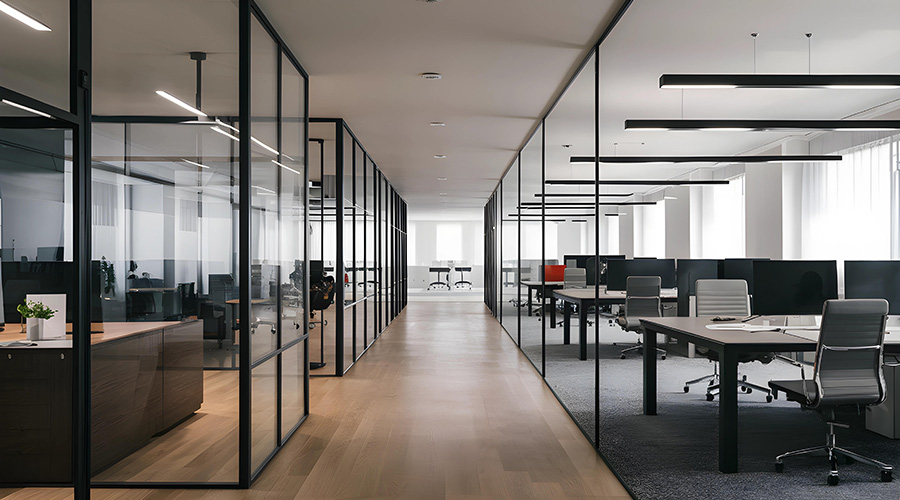Going Virtual
For facility executives, the challenge of the new work environment is supporting workers anywhere, anytime.
By Steve Hargis and Mia Jacobsen
Until recently, the phrase “virtual work” referred to tasks completed away from the traditional physical office space. But many now use it to loosely encompass a broader set of workplace arrangements: accommodating home-based teleworkers, after-hours workers, on-the-road employees, and even outsourced workers. But, just as many companies have dropped the word “alternative” from the phrase “alternative officing,” because those arrangements have become the norm, the word “virtual” may some day be dropped from the phrase “virtual work” because it’s becoming redundant. Employees just work, albeit in multiple locations using a variety of work tools, and facility executives must accommodate their needs.
Advances in information and communication technology, including wireless Internet solutions and products, are continually producing growth of this virtual workforce. The “work anytime, anywhere” concept is very real. Creative applications of technology will enable a seamless flow of information across great distances.
In 1997, there were approximately 8 million people involved in some form of virtual work, according to the International Association of Virtual Organizations. The Gartner Group, a technology research firm, predicts that by 2008, 41 million employees around the world will spend at least a day a week teleworking. Nearly 100 million will work from home at least one day each month. The largest proportion of these employees will be U.S. workers.
Much research has been conducted on the concept of telework. Teleworking benefits everyone — employers, employees, self-employed individuals and entrepreneurs. Employers reduce costs associated with real estate, overhead and attrition. Employees save on commuting and personal expenses. Society benefits because fewer cars on the road at peak times means less congestion and a cleaner environment.
But telework is only one piece of a larger trend. The term “office” now extends beyond hard walls and cubicles. It now includes the home, coffee shops, Wi-Fi active spaces, parks and airports — virtually anywhere one can connect, access and transfer data.
Rethinking the concept of space
Knowledge work is the fastest growing component of the 21st century workplace, forcing companies to rethink the traditional space model and consider additional work arrangements to accommodate fluidity, transient work forces and vastly differing types of work. Workplace planning is more difficult than it has been in the past because it must take into account a variety of factors.
• “Next-Gen” workforce: a younger workforce without the preconception that physical presence in an office is a determinant of work.
• Technology: a stronger integration of computers, communication technology and consumer devices available at lower costs.
• Globalization: the interdependence of data, goods, money and ideas
• Competition: a fierce competition for global market share, with agile, innovative companies being the winners.
• Change: a volatile business environment demands agility and speed to keep up with changing markets.
• Social inventions: essential new business models to keep up with the e-commerce revolution.
Each of these factors is complex enough to turn a less-than-forward-thinking space allocation program into a liability for the organization.
There are two ways to think about real estate, according to John Vivadelli, president and CEO of AgilQuest: abundance and scarcity. “The mindset of abundance says that the organization should provide enough assets for any possible peak-usage load.” This mentality has gotten many organizations into trouble because it leads them to procure too much real estate — real estate that cannot be sustained through market peaks and valleys.
“Organizations with the mindset of scarcity treat every asset as expensive and valuable,” says Vivadelli. “The organization bases cost accounting on actual use rather than predetermined allocations and constantly evaluates and decides the best mix of people, facility and technology assets required to produce the best ROI.”
A scarcity mindset makes it essential to closely consider assets and their allocation. Facility executives may not have to strip away space and create radical space arrangements, but instead re-engineer space so that it encourages the creation and exchange of knowledge. This can be achieved by building strong relationships among human resources, IT, finance and real estate, and by addressing work as a holistic system of interrelated places and issues.
Space, technology and services
So how does all this affect facilities and the services facility executives provide internal customers, both in and out of the office? Because the profile of virtual workers is characterized by their mobility and need to conduct business “anywhere, anytime,” the foundational concern is providing connectivity, work tools and support services. The office itself is one of many important physical places supporting the work process. But the facility cannot compensate for the lack of connectivity, work tools and support services.
Regardless of work location, facility executives need to provide several tools for workers.
1. Absolutely consistent connectivity available for voice, data and video in the office, at home and on the road. This may include:
• Both wired networks that provide speed and allow large or secure file transfer and wireless networks provide maximum flexibility.
• High-speed data connections, like DSL, cable, and, in cases where data transfer is minimal or non-critical, dial-up, in secondary work locations such as home, hotels and customer sites
• Wi-Fi access in public places like coffee shops, airport lounges and waiting areas.
• Internet-enabled service for a growing number of mobile personal communication devices, such as the IPAQ, Blackberry, Treo and many mobile phones.
2. Appropriate software, devices and other work tools to support the work being done, such as:
• Collaboration software, for example, LiveMeeting, NetMeeting and Meeting Place, for Web conferencing.
• Instant messaging capabilities.
• Virtual private network access while logging in from outside the facility.
• Desktop video; IP phones; laptops; PDAs and other mobile devices
3. Support services, such as:
• Space reservation systems to ensure appropriate space is available before a worker comes to the office and to track use over time to fine-tune the types and quantities of space provided.
• Concierge services to help mobile employees set up their work areas before their arrival.
• Mail and package delivery to ensure that mobile employees receive packages in a timely manner without making special trips to the office.
• Planning social events to help keep scattered employees connected.
In addition, in the world of virtual work, an organization must reorient both human resource and management practices to address the needs of workers who spend less time in the office. Companies must reward work output and content of work as opposed to physical presence. With more employees on larger distributed teams, organizations are slowly catching on to new practices. Workers are learning how to deal with team members who rarely interact face-to-face. Organizations, however, should enforce some amount of “face time,” both for work and social purposes, to build a strong work community.
The office proper
Another appropriate question for anyone involved in providing and managing physical space is what will or should be different about the space. Most observers say the key is functional variety. When virtual workers come into the office, they usually come to accomplish a specific type of task or interaction. Many studies, especially in the high-tech and service industries, have shown that assigned offices or cubes are often unoccupied upwards of half the time. The variety of tasks performed in the office requires a range of space types: open and enclosed, public and private, individual and group, owned and unassigned.
Providing the correct mix of spaces for a specific group of employees may lead to gains in productivity. Engineered correctly, the variety of spaces benefits everyone.
Because the concepts of virtual work and the workspace of the future are evolving, it’s safe only to say that facility executives must start reshaping conceptions of and approaches to work space. As telecommuting expert Gil Gordon says: “The best way to answer the question of who will work where is to encourage managers and employees to ask, ‘Where can I work tomorrow given my spectrum of needs and where will I add most value tomorrow?’”
Steve Hargis is vice president and Mia Jacobsen is senior consultant of HOK Advance Strategies, a consulting firm that works with clients to help them align their business strategies with their real estate, facilities, and workplaces. Both are based in San Francisco.
Supporting the mobile workforce within the office
Cisco’s Workplace Effectiveness (WPE) team has been defining and testing workplace concepts that will better support the nature of work in today’s changing business environment. The first of a series of proof-of-concept (POC) installations, completed in the summer of 2004 at the company’s San Jose campus, is being occupied by approximately 140 participants. At roughly 114 square feet per person, this space at the campus of 16,000 employees has significantly higher utilization than the norm.
Chris Ross, manager of solutions and program development for Cisco’s WPE team, has been involved in developing the strategy for the POC installations and the overall workplace effectiveness initiative.
“The basic premise is that all employees are mobile within the office and therefore don’t spend all of their time in a single space during their day,” Ross says. “We have provided a variety of settings to support work, ranging from individual private, focused space to open and collaborative areas, both face-to-face as well as remote. There are no assigned offices, even for the management team, although they have access to that type of space when they need it.”
Goals for the POC installations are simple and straightforward:
- Support individual and team productivity.
- Positively affect occupant satisfaction.
- Optimize total cost of operating.
With Cisco’s extensive offering of network-centric hardware and software products, one primary goal of the Building 14 POC installation is to leverage that technology. Technology defines the functionality of the majority of work areas provided, and in doing so, provides a sales story for Cisco to use in the external market. This POC installation includes the following technology components:
- For individuals, the installation offers a wireless converged network for voice, video and data, mobile technology, IP telephony, flat-screen monitors and docking stations.
- For collaborative work, the installation offers plasma screens, interactive whiteboards, collaborative software, IP conference phones and video conference equipment.
Cisco’s own product line of telephony options is an advantage in this type of environment. In the traditional office, the phone anchors a person to a specific desk. Now, employees using the space have three options for receiving calls:
1. Extension mobility allows any employee to enter a code into a handset and immediately convert that phone to his or her own with the full functionality of speed dials and other features.
2. A software package on the laptop, Cisco IP Communicator, brings calls over the network to the laptop. This solution requires the use of a hardwired or Bluetooth-enabled wireless headset, and allows additional mobility within the space and any other location where the employee can connect to the network.
3. A wireless IP phone, the Cisco 7920, functions while inside a Cisco facility where it can pick up the network data signal. This solution resembles a typical mobile phone, though it is limited to the network in the office.
The physical space in the POC installation layout includes a wide variety of settings to support individual and group work, socialization, and relaxation:
- A heavily branded entry space is used to orient and explain POC concepts as well as to gather extemporaneous feedback on the space.
- A community-activity hub integrates group meeting capabilities and collaboration technology with break-room amenities.
- Flexible group meeting spaces feature operable walls and mobile tables.
- Workplace options for teams and individuals include open, semi-open and enclosed collaboration spaces, touch down areas, and individual work stations.
- Three types of work surfaces allow employees to create different furniture configurations to support different work activities. Three types of task chairs plus soft seating areas support employees with various ergonomic needs.
- Docking stations allow quick connection to desktop accessories like flatscreen monitors and keyboards.
- One-stop office equipment multifunction devices leverage the IP network for printing, faxing, copying, scanning and emailing.
- New online storage allocation methods greatly reduce storage needs. Individuals are allocated one personal locker and one lateral filing drawer.
- A service center offers workplace services like laundry, shipping and package delivery.
- Individual storage lockers aid mobile workers.
- A library that provides a quiet zone.
Ross notes two significant challenges that Cisco continues to study.
First, the new POC environment has negated traditional planning metrics around capacity and occupancy measures. Current metrics focus on individual usage of space, but in the POC environment it is really the dynamic of the team or group that is critical. Use can be measured by several methods, all currently being tested, including physical observation, RFID tracking and employee badging records.
Secondly, mobile workers have unique needs when it comes to distributing mail and packages. Mail room staff now scans all incoming documents for electronic delivery. Packages are delivered to centralized lockers in the building; recipients pick their packages up at their convenience after receiving an e-mail notification providing the locker number and temporary security access code. This system has proven to be a cost savings over previous mail and package delivery systems for this facility.
Despite those challenges, Ross also sees clear benefits. “The Cisco Connected Workplace will have a huge impact on the real estate portfolio for Cisco,” he says. “As we learn about the best ways to leverage technology, space and services in support of our business, we are reducing the reliance on real estate while maintaining, and hopefully increasing, employee satisfaction and productivity.”
|
Related Topics:











